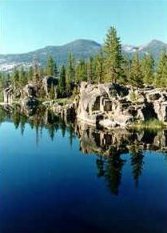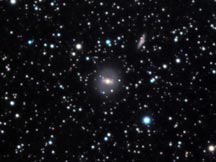Astro 28D: Field Astronomy - Comet Studies at Mono Hot Springs
Sept 30-Oct 2, 2011
Schedule
Post-Trip Pix from Kirk Bender
 The special focus for this field course will be on studying two bright comets passing through the inner solar system, and also on a possible occultation of a star by an asteroid. Our course will be conducted at Mono Hot Springs, in the Sierra about 50 miles northeast of Fresno. We'll have an orientation and sign-up for the course on Tuesday evening Aug 30 at 5:30pm in room 705. Then, a pre-trip class on Thursday eve 5-10pm Sept 29 in the planetarium (room 706a) which will include logistics, maps, help with carpooling, and lectures and slides on the formation of the solar system, comets, and asteroids. You'll transport yourself to the campsite (no yellow school bus. You're in college now!). I'll meet you at Mono Hot Springs Friday evening Sep 30. During the evenings, we'll study the planets, and galaxies, and the denizens of the Milky Way Galaxy in which we live - star formation regions, binary stars, massive hot stars, dim red dwarfs, newly dead stars, supernovae remnants... and of course, a rare opportunity to see not one but two bright comets in the sky. This weekend also has an asteroid which pass in front of a distant faint star , and whose path crosses somewhere in central California. The odds are 1/5 that the path will cross Mono Hot Springs, but we will video-record the event in case it does. I'll explain to the class the process of asteroid occultation planning and observation including GPS time-stamped video-recording.
The special focus for this field course will be on studying two bright comets passing through the inner solar system, and also on a possible occultation of a star by an asteroid. Our course will be conducted at Mono Hot Springs, in the Sierra about 50 miles northeast of Fresno. We'll have an orientation and sign-up for the course on Tuesday evening Aug 30 at 5:30pm in room 705. Then, a pre-trip class on Thursday eve 5-10pm Sept 29 in the planetarium (room 706a) which will include logistics, maps, help with carpooling, and lectures and slides on the formation of the solar system, comets, and asteroids. You'll transport yourself to the campsite (no yellow school bus. You're in college now!). I'll meet you at Mono Hot Springs Friday evening Sep 30. During the evenings, we'll study the planets, and galaxies, and the denizens of the Milky Way Galaxy in which we live - star formation regions, binary stars, massive hot stars, dim red dwarfs, newly dead stars, supernovae remnants... and of course, a rare opportunity to see not one but two bright comets in the sky. This weekend also has an asteroid which pass in front of a distant faint star , and whose path crosses somewhere in central California. The odds are 1/5 that the path will cross Mono Hot Springs, but we will video-record the event in case it does. I'll explain to the class the process of asteroid occultation planning and observation including GPS time-stamped video-recording.
We explored Mono Hot Springs at the Astro 28W course in fall '07. Check out the Astro 28W post-trip photo page here.

The campground is first come / first serve
in late September, and is right on the south fork of the San Jaquin River
|

South fork of the San Jaquin River near
camp. One of the hot springs is immediately across the river from the campground
|

Doris Lake, near camp, will be a mid-day destination for lectures (see first image of this page), lunch, and a swim
|
Here's the details of the astronomical highlights - the asteroid and comet events (posted conveniently for my own planning)
1. The occultation by the asteroid Automedon at 3:40am Saturday morning, 35 degrees altitude. The nominal path crosses Lake Tahoe. Odds that the actual path will cross Mono Hot Springs are 18%. These events are valuable for measuring precisely the size and shape of asteroids - something which otherwise can only be done with mega-million dollar space missions. This event has favorable characteristics and will likely be observed by other astronomers along the path as it crosses New Mexico and Texas. Combining our observations with theirs will allow a precise shape for the asteroid to be measured.
We get to study two bright comets, both reaching maximum brightness about this time. One is a short-period comet which has had its structure affected by perihelion passages many times, and one is a new comet which will have a different chemical composition near the surface, quite possibly, which will affect it's appearance. Frequently it means a brighter and more spectacular tail as fresh material evaporates.
2. Studying Comet Garradd
This comet was discovered just a year ago, however it will be a bright object easily visible in binoculars at 6th magnitude for much of Fall  '11, nicely placed in the evening sky in the constellation of Hercules. The comet deserves special attention as it is rare for a comet this bright to have gone un-discovered for so long. Its orbit or surface conditions may have changed recently. The comet will make a photogenic passage by the galaxy pair NGC 6548/NGC 6549 on Saturday and Sunday evenings. I plan to bring an 8" telescope especially for study and imaging of this comet and this conjunction. Astro 9 students are urged to sign up for Astro 28D if they'd like a chance to get images of this for their portfolio for class.
'11, nicely placed in the evening sky in the constellation of Hercules. The comet deserves special attention as it is rare for a comet this bright to have gone un-discovered for so long. Its orbit or surface conditions may have changed recently. The comet will make a photogenic passage by the galaxy pair NGC 6548/NGC 6549 on Saturday and Sunday evenings. I plan to bring an 8" telescope especially for study and imaging of this comet and this conjunction. Astro 9 students are urged to sign up for Astro 28D if they'd like a chance to get images of this for their portfolio for class.
3. Studying Comet Elenin
This comet was discovered Dec 10, '10 and was looking like it may steal the show as quite a nice comet in the late September morning sky. The comet will pass between the sun and the Earth, which is the most spectacular configuration for producing a beautiful bright comet as forward-scattering of sunlight through dust makes for bright comet tails (a'la Comet McNaught '07 and Comet West in '76). Alas, it is a small comet and it did not survive it's swing around the sun in early September - melting away to nothing. You can still follow it's fading brightness at the future comets website. I've taken this one off our list of objects to look at.
4. Studying Comet Honda-Mrkos-Pajduskova
Discovered in 1948, this comet orbits the sun every 6 years. In 2011, it passes as close to the Earth and Sun as close as it can come, and nearly on the same day - it's the brightest this comet ever gets in our sky, and one of the closest comet passes by Earth we have seen - only 0.1 AU (9 million miles). We'll see the comet as a large, diffuse glow near Regulus in Leo in the morning sky.
Planetary Processes Studies
During the day, we'll hike to Doris Lake and have my unique "micro-lectures" which relate the geologic history of the Sierra and California to the planetary processes on the other inner planets. We'll also visit two or three of the hot springs which emerge here - including "Little Eden", spectacularly perched on the edge of a steep mountainside with a panoramic vista of the Sierra (see Astro 28W post-trip photos page). I'll pass out materials for study as well, in the field.
Signing up for the Class
Rules of the Class, Grading
Camper's Checklist
 The special focus for this field course will be on studying two bright comets passing through the inner solar system, and also on a possible occultation of a star by an asteroid. Our course will be conducted at Mono Hot Springs, in the Sierra about 50 miles northeast of Fresno. We'll have an orientation and sign-up for the course on Tuesday evening Aug 30 at 5:30pm in room 705. Then, a pre-trip class on Thursday eve 5-10pm Sept 29 in the planetarium (room 706a) which will include logistics, maps, help with carpooling, and lectures and slides on the formation of the solar system, comets, and asteroids. You'll transport yourself to the campsite (no yellow school bus. You're in college now!). I'll meet you at Mono Hot Springs Friday evening Sep 30. During the evenings, we'll study the planets, and galaxies, and the denizens of the Milky Way Galaxy in which we live - star formation regions, binary stars, massive hot stars, dim red dwarfs, newly dead stars, supernovae remnants... and of course, a rare opportunity to see not one but two bright comets in the sky. This weekend also has an asteroid which pass in front of a distant faint star , and whose path crosses somewhere in central California. The odds are 1/5 that the path will cross Mono Hot Springs, but we will video-record the event in case it does. I'll explain to the class the process of asteroid occultation planning and observation including GPS time-stamped video-recording.
The special focus for this field course will be on studying two bright comets passing through the inner solar system, and also on a possible occultation of a star by an asteroid. Our course will be conducted at Mono Hot Springs, in the Sierra about 50 miles northeast of Fresno. We'll have an orientation and sign-up for the course on Tuesday evening Aug 30 at 5:30pm in room 705. Then, a pre-trip class on Thursday eve 5-10pm Sept 29 in the planetarium (room 706a) which will include logistics, maps, help with carpooling, and lectures and slides on the formation of the solar system, comets, and asteroids. You'll transport yourself to the campsite (no yellow school bus. You're in college now!). I'll meet you at Mono Hot Springs Friday evening Sep 30. During the evenings, we'll study the planets, and galaxies, and the denizens of the Milky Way Galaxy in which we live - star formation regions, binary stars, massive hot stars, dim red dwarfs, newly dead stars, supernovae remnants... and of course, a rare opportunity to see not one but two bright comets in the sky. This weekend also has an asteroid which pass in front of a distant faint star , and whose path crosses somewhere in central California. The odds are 1/5 that the path will cross Mono Hot Springs, but we will video-record the event in case it does. I'll explain to the class the process of asteroid occultation planning and observation including GPS time-stamped video-recording. 


